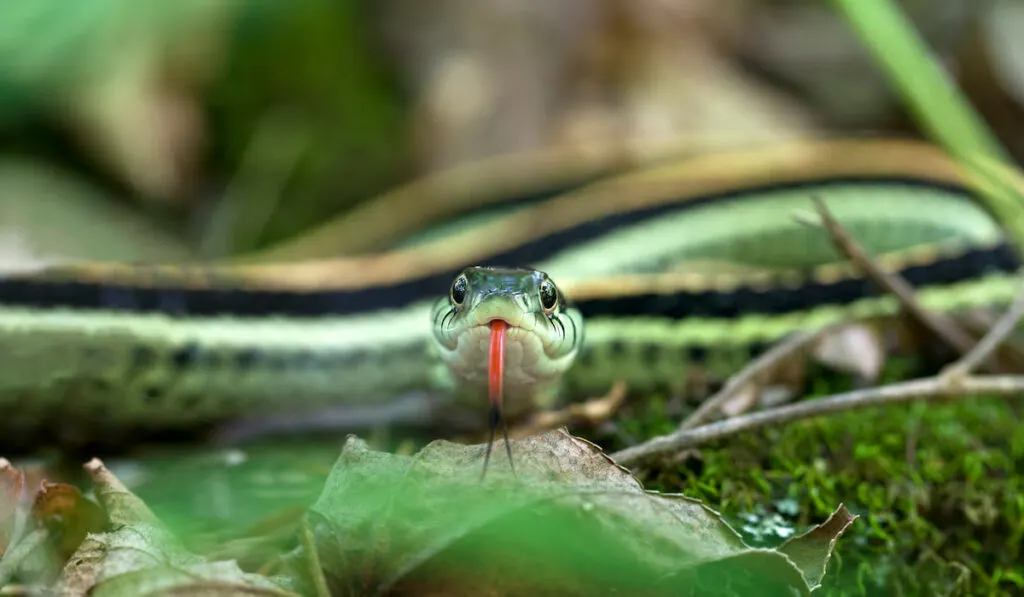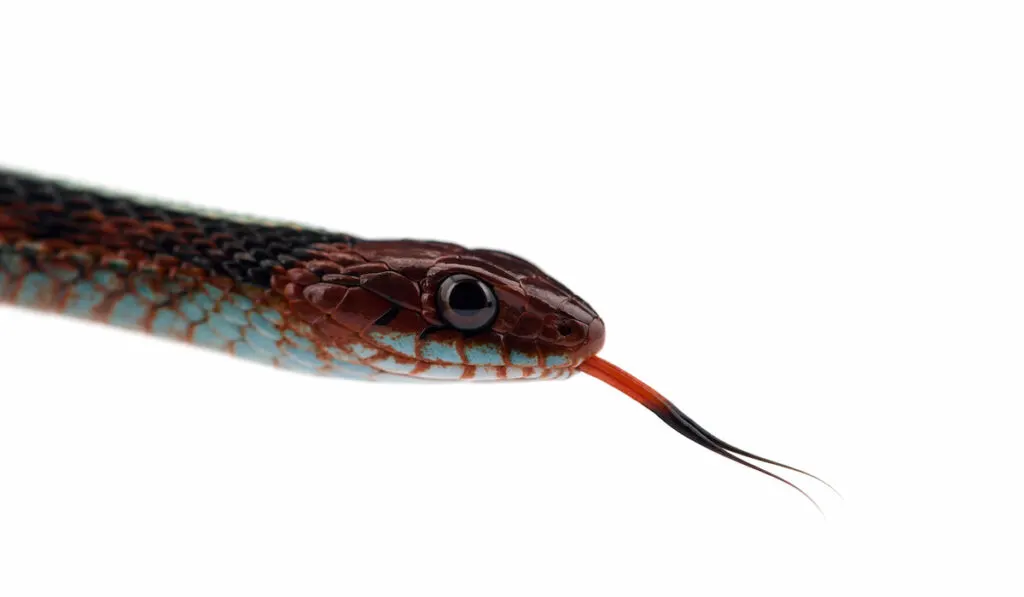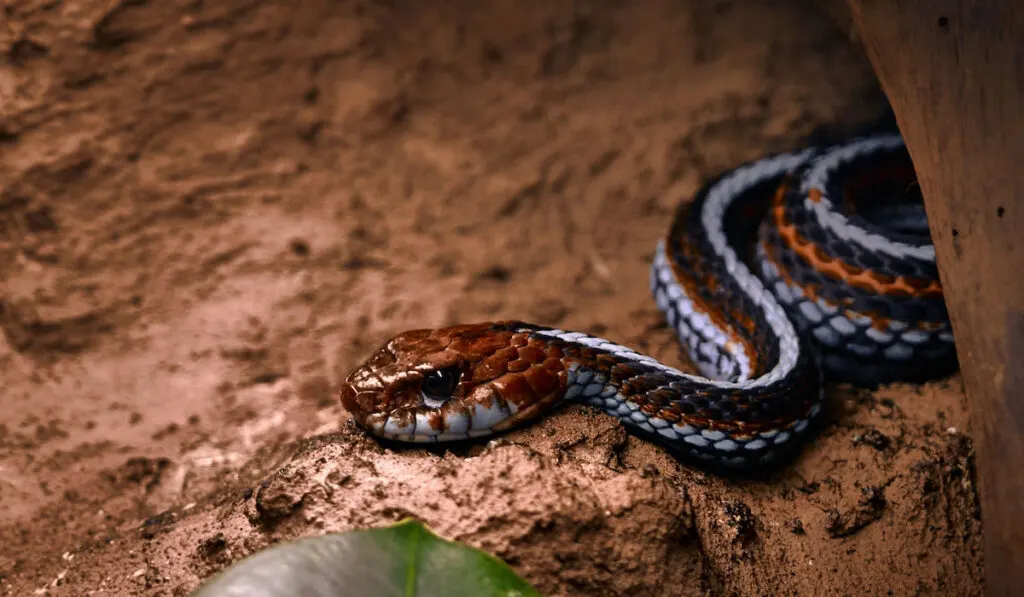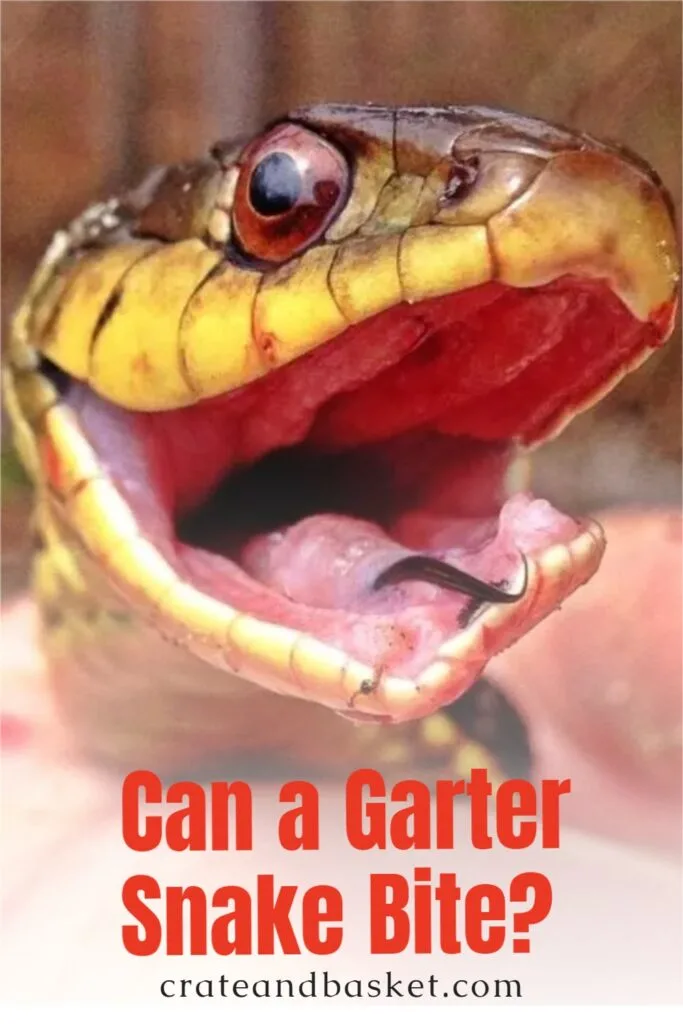You may be startled to see a snake sneaking around in your backyard.
However, this is North America and you may realize it’s probably a garter snake which is commonly found in grassy areas.
So now you’re wondering, are garter snakes dangerous? Can they kill you? We’ll try to answer all your questions in this article.

Table of Contents
Can a garter snake bite?
A garter snake can bite, although it is unlikely for them to bite humans unless threatened or provoked.
While their bite is considered non-venomous, a person bitten by garter snake bite should wash the bitten area thoroughly.
Their bite can cause minor swelling and itchiness.
Some people can have allergic reactions to their saliva according to the Animal Diversity Web (ADW), although it is extremely rare.
In addition, garter snakes are known to release foul-smelling musk before attacking their prey.
While the musk is harmless, it can leave a skunk-like smell on its victim.

Do garter snakes have teeth?
Although they are not highly visible, garter snakes do have two large, sharp teeth at the back of their mouth which they use to catch prey.
With the help of mild neurotoxin that is present in their saliva, small prey becomes easier to swallow.
Does a garter snake bite hurt?
Like any animal’s bite, the garter snakes’ bite will hurt, but it is unlikely to cause serious issues, or even death.
Some species do contain venom, although it is not considered significantly toxic to humans.
However, if bitten by a garter snake, it is best to clean it with soap and water to prevent bacteria build up.
It is also important to take a tetanus shot, just like what you would do when bitten by other animals.
Will a garter snake bite a dog? A cat?
As mentioned, garter snakes are mildly venomous, which means their bite can cause side effects, although it is not considered fatal.
A dog loves to run around your backyard, which means they may encounter garter snakes lurking around.
They may see snakes as playmates, and they don’t have the ability to determine a venomous and non-venomous snake.
The dog’s reaction will depend on his encounter with the garter snake.
Did your dog eat the snake, or did he kill it without ingesting any of it? Has your dog been bitten by the snake?
These factors will determine if the encounter needs immediate action or not.
Also, since garter snakes emit musk as a defense to their predators, your dog may experience mild dizziness, salivating, and swelling in the bitten area.
Check where your dog is bitten, usually on the head or around the neck.
A bite on your dog’s body is considered dangerous, regardless if the snake is venomous or not.
If that is the case, check with your veterinarian immediately as most snake bites affect the cardiopulmonary system which causes blood clots.
Like dogs, cats may also suffer from mild symptoms, such as swelling and itching around the bitten area.
Clean the wound immediately to lessen the risk of infection. If a wound is infected or if you are not sure, it is best to consult with a veterinarian.

Are garter snakes friendly?
Garter snakes are harmless to humans, and can be kept as pets.
However, you should not catch wild ones as it may be against the law. Rather, buy one from the pet store or from a reputable breeder.
When it comes to their fellow garter snakes, they are considered social and would prefer hanging out together.
Some also form bonds, thus being friends, especially with those who they spend most of their time with.

What do they eat?
Part of the garter snake’s diet includes insects, toads, earthworms, amphibians, slugs, leeches, snails, crayfish, small fishes, as well as other snakes.
In some cases, they eat lizards, baby birds, and small mammals such as rodents. Because of this, garter snakes are considered a gardener’s best friend.
Garter snakes have an outstanding sense of smell and vision which they use to forage.
Once they have found their target, garter snakes use various hunting methods, including peering, craning, and ambushing.
The mild toxin present in their saliva is useful to paralyze smaller prey. Like every other snake, garter snakes eat their food whole.

Where do they sleep?
Garter snakes are highly adaptable, and can be found in different types of habitats.
They are commonly seen on meadows, marshes, woodlands, and hillsides. They also love to stay in moist grass, and can be found near water.
In addition, they are also present in urban and suburban areas where there is cover, such as debris, vegetation, tall grass, or rocks.
Garter snakes are commonly active during warm seasons such as spring and summer, while they hibernate during winter.
They occupy secluded spots, called hibernacula, to keep them warm during this season.
However, they are often seen out in the sun to raise their body temperature, since they are cold-blooded like every other reptile.
Meanwhile, they may occupy dark areas during spring and summer. They are also seen on grass, under the leaves, or logs where they can camouflage.

What states have garter snakes?
Garter snakes are common in North America, and can be found anywhere from Alaska to Florida.
In fact, it is the state reptile of Massachusetts. However, there are no traces of them in Southwest.
Are garter snakes good to have in your yard?
A few garter snakes are very helpful in your yard and garden since they eat annoying pests, such as slugs, leeches, grasshoppers, and rodents that may eat your plants and vegetations.
That said, they make a natural source of pest control.
However, too many garter snakes are not beneficial in your yard. First of all, your visitors may be frightened with the presence of garter snakes.
Also, they may bite you if you accidentally step on them since they perceive you as a threat.
Lastly, garter snakes cannot identify harmless and beneficial bugs, so if you grow vegetables, fruits, or flowers in your yard, they may kill good insects and bugs accidentally.

How do you identify a garter snake?
Since you are not sure what type of snake is sneaking in your area, the first thing you should do is observe from a distance.
Usually, a garter snake’s size ranges from 18 to 54 inches (45.7 to 137.16 cm). They also have stripes on their body that are either yellow, brown, or blue in color – one at the center, and one on each side.
However, some garter snakes don’t have stripes, so even if there are no stripes present on the snake’s body, it could still be a garter snake.
Identify the color of the snake’s body. Usually, a garter snake may be in the color of brown, gray, black, and olive.
Some may have checkerboard patterns, with scales that looks rough and a raised ridge.
A garter snake’s head is dark, and is wider than its neck. The throat, chin, and belly have the same color as the stripes, and the tongue should be red with a black tip.
If you’re still unsure, look for photos online so you can compare the garter snake and the snake in your yard.
Final Thoughts
Hopefully this article answered all your questions about garter snakes.
If you know someone who needs to know more about garter snakes, please share!

References:
- https://www.terminix.com/blog/education/are-garter-snakes-poisonous/
- https://www.livescience.com/44072-garter-snake.html
- https://www.freep.com/story/news/local/michigan/2019/05/22/garter-snakes-teeth-bite/3750700002/
- https://www.mercurynews.com/2013/07/16/morris-garter-snake-venom-wont-hurt-humans/
- https://uniquepetswiki.com/are-garter-snakes-poisonous-to-dogs/
- https://www.cuteness.com/blog/content/are-garter-snakes-dangerous-to-dogs
- https://peteducate.com/are-garter-snakes-poisonous/
- https://animals.howstuffworks.com/snakes/garter-snakes.htm
- https://vtfishandwildlife.com/learn-more/vermont-critters/reptiles/common-garter-snake
- http://www.biokids.umich.edu/critters/Thamnophis_sirtalis/
- https://dickinsoncountyconservationboard.com/2019/12/09/how-garter-snakes-spend-the-winter/
- https://www.wikihow.com/Find-a-Garter-Snake
- https://www.havahart.com/articles/how-to-get-rid-of-garter-snakes
- https://homeguides.sfgate.com/identify-rid-garter-snakes-84647.html
- https://www.sciencemag.org/news/2020/05/garter-snakes-are-surprisingly-social-forming-friendships-fellow-serpents
- https://vtfishandwildlife.com/learn-more/vermont-critters/reptiles/common-garter-snake
